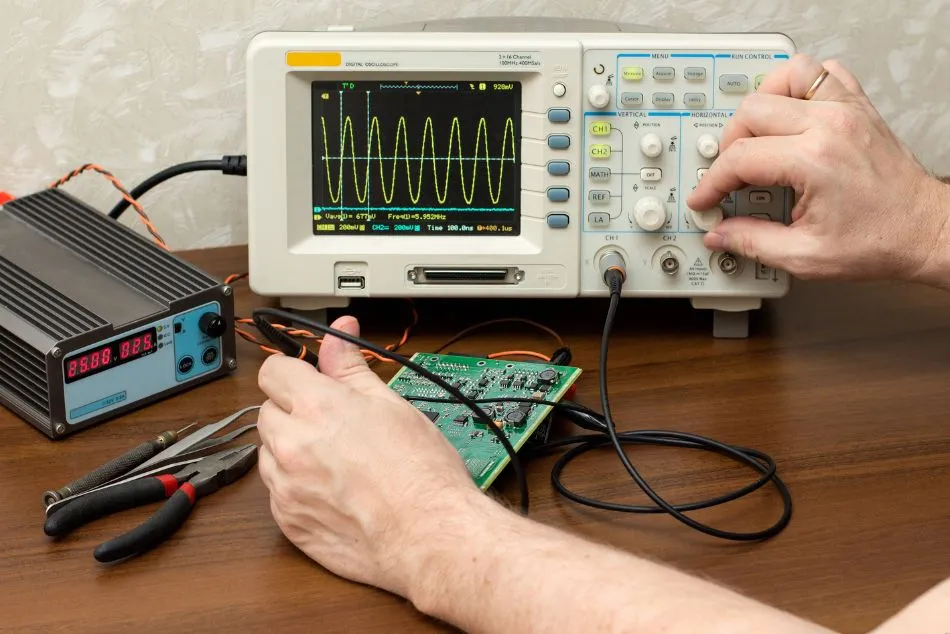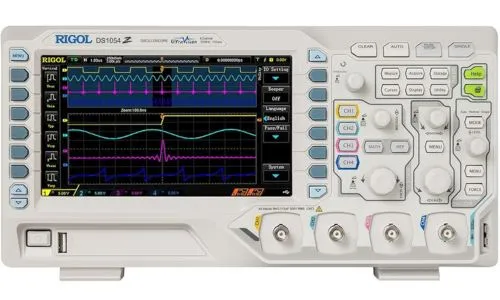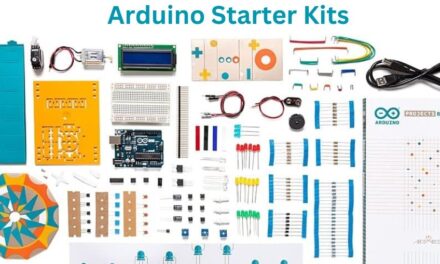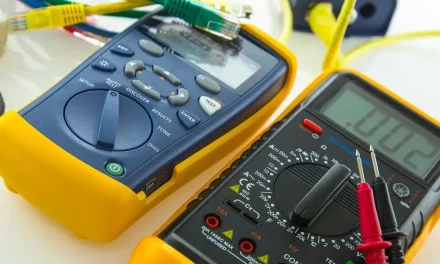An oscilloscope is one of the most important devices in electronics that is used to display and analyze the waveform of electronic signals. They are used by engineers to quickly test, verify, and debug their circuit designs.
In this article, we’ll explore several entry-level oscilloscopes suitable for electronics beginners or hobbyists. We’ll also help you to select the best oscilloscope for your needs.
How to Choose the Best Oscilloscope?
When it comes to choosing the right oscilloscope, there are many different parameters to consider. Here are some of the important features you should look for before purchasing an oscilloscope.
Bandwidth: Bandwidth is often considered as the most important feature of an oscilloscope. It defines the range of frequencies that the oscilloscope can accurately measure. It is measured in Hertzs(Hz). An oscilloscope with higher bandwidth can accurately measure a wider range of frequency signals without significant signal distortion or attenuation. Entry-level oscilloscopes typically have a bandwidth ranging from 25MHz to 200MHz.
Sampling Rate: Sampling rate is the number of samples that an oscilloscope collects each second. It is specified in samples per second (S/s). The higher the sampling rate is, the greater the resolution of the displayed waveform and the less likely that important detail is lost.
Memory depth: Memory depth refers to how much data the oscilloscope can store. It is closely related to the oscilloscope’s sample rate. As the oscilloscope takes samples of waveforms, it stores this data in its memory. It is measured in “points” rather than bytes. For example, an oscilloscope with a memory depth of 24 Mpts can store 24 million samples. The higher the memory depth, the more data the oscilloscope can capture and record of a signal.
Number of Channels: The number of channels indicates how many signals you can view and analyze simultaneously. More channels provide greater flexibility and are particularly useful for multi-signal analysis, such as in complex electronic systems. For a beginner, a 2-channel scope is usually sufficient.
Price: Price is always a key consideration, whenever we are buying something. If you are a hobbyist, an entry-level oscilloscope might be sufficient for your needs. You can easily get a good entry-level oscilloscope for a couple of hundred dollars.
Best Entry Level Oscilloscopes
Let’s look at some of the best entry-level oscilloscopes that offer a great balance between features and affordability.
Rigol DS1054Z Digital Oscilloscope
The Rigol DS1054Z is one of the most popular entry-level digital oscilloscopes. It offers 4 channels, a bandwidth of 50 MHz, several measurement functions and a 7-inch WVGA LCD display with resolution of 800×480 pixels. With this large display you can visualize all 4 channels together with full bandwidth, compare signals and find bugs faster with better visibility. Its 12 Mpts memory depth ensures detailed capture of long signals. You can even zoom in to view small signal details in the signal record.
This oscilloscope has serial bus triggering options, including edge, pulse width, and video, ensuring precise signal analysis. It also has serial bus decoding options for RS-232, UART, I2C and SPI. It has a refresh rate of up to 30,000 wfms/s, enabling quick detection of signal anomalies. It can record up to 60,000 frames of a dynamic signal and play them back for analysis.
All these features are pretty good for this price range and makes the device very attractive.
Main Features:
- Bandwidth: 50 MHz
- Channels: 4
- Sample Rate: 1 GSa/s (single channel)
- Memory Depth: 12 Mpts (standard), upgradable to 24 Mpts
- Waveform Capture Rate: Up to 30,000 wfms/s
- Display: 7 inch WVGA (800×480) TFT LCD, intensity graded color display
- Interfaces: USB Host & Device, LAN (LXI), AUX
- Functions: Various trigger and bus decoding functions
- Real-time Waveform Recording and Playback (up to 60,000 frames)
Accessories Included:
- 1 x DS1054Z Oscilloscope
- 2 x probes
- 1 x Power Cord
- USB Cable
Hantek DSO5102P USB Storage Oscilloscope

The Hantek DSO5102P is a 2-channel digital oscilloscope with 100 MHz bandwidth. It features a 7-inch 64K color TFT LCD display with 800×480 resolution that can clearly display waveforms. It can measure 32 different types of waveform parameters automatically.
One of the standout features of the Hantek DSO5102P is its multiple trigger modes, including Edge, Video, Pulse, Slope, Over time, Alternative which provide flexibility in capturing complex signals. The oscilloscope also includes a built-in FFT function for frequency domain analysis, making it a powerful tool for both time-domain and frequency-domain analysis. It also has onboard storage capable of storing up to 1000 waveforms information. Additionally, it supports USB connectivity for data transfer and firmware updates, enhancing its usability and convenience.
This scope is very easy to setup and use. Also, measuring the signals properties is very easy with its intuitive interface and menu. The material and the build quality are also good good. It also includes a 1 KHz square wave probe that enables you to test and calibrate your scope easily.
In terms of performance, the oscilloscope reliably captures and displays signals with high accuracy, thanks to its high sampling rate and adequate bandwidth. This makes Hantek a very good option for a very reasonable price for beginners.
Main Features:
- Bandwidth: 100 MHz
- Channels: 2
- Sample Rate: 1 GSa/s
- Memory Depth: 40 Kpts
- Display: Large 7-inch 64K color TFT LCD display with a resolution of 800 * 480
- Trigger mode: edge/pulse width/line selectable video/slop/overtime etc
- Connectivity: A RS232C or USB standard serial port
- Functions: Four math functions, including FFTs standard
- 32 types of automatic measurements
- Provides software for PC real-time analysis
Accessories Included:
- 1 x 5102P Oscilloscope
- 2 x Connecting Lines
- 1 x USB Cable
- 1 x Installation CD
- 1 x Power line
Siglent SDS1202X-E Digital Oscilloscope
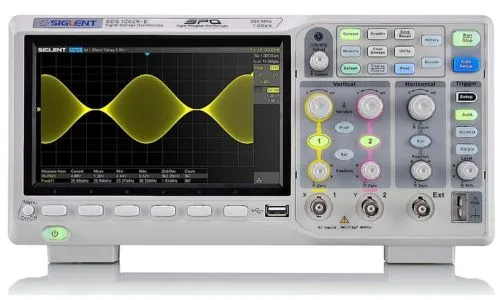
The Siglent SDS1202X-E is a high-performance digital oscilloscope featuring the new generation of SPO (Super Phosphor Oscilloscope) technology that provides excellent signal fidelity and performance. This 2-channel oscilloscope offers a bandwidth of 200 MHz, providing excellent signal capture and analysis capabilities. It features a large, wide-screen, 7-inch TFT-LCD display with 800 * 480 resolution, sample rate of 1GSa/s and a standard record length of 14 Mpts and a waveform capture rate of 400,000 frames/sec.
The device has a few remarkable extra features that are usually not present on the other two-channel scopes. It comes with an innovative digital trigger system, a 256-level intensity grading display function and a colour temperature display mode. Another powerful feature is the new math co-processor that enables FFT analysis of incoming signals using up to 1M samples per waveform. It also has a History Mode feature that allows you review past waveforms to analyze signal behavior over time.
Another notable feature is the advanced math functions, including FFT, integration, differentiation, and various arithmetic operations. The oscilloscope includes serial bus decoding for I2C, SPI, UART/RS232, CAN, and LIN protocols, enhancing its utility in embedded systems development. It supports multiple triggering modes including Edge, Slope, Pulse Width, Window, Runt, Interval, Dropout, Pattern, Video. It also has multiple types of interfaces including USB Host, USB Device (USB-TMC), LAN (VXI-11), Pass/Fail and Trigger Out. These features of Siglent gives you enough reasons to give it a try.
Main Features:
- Bandwidth: 100 MHz-200 MHz
- Channels: 2
- Memory Depth: 14 Mpts Record length
- Sample Rate: 1 GSa/s
- Waveform Capture Rate: up to 100,000 wfm/s (normal mode), and 400,000 wfm/s (sequence mode)
- Display: Large 7-inch TFT-LCD display with 800 * 480 resolution
- Intelligent Trigger Option: Edge, Slope, Runt, Pulse Width, Window, Interval, Timeout (Dropout), and Pattern
- Free Serial bus triggering and decoding: IIC, SPI, UART, RS232, CAN, and LIN
- Automatic measurement function on 38 parameters
- History waveform record (History) function
- Math co-processor speeds front panel operation
- Multi-language display and embedded help
- Highspeed hardware based Pass/ Fail function
- Video triggers and supports HDTV
Accessories Included:
- 1 x Siglent SDS1202X-E Oscilloscope
- 2 x 200MHz probes
- 1 x Power Cord
- 1 x USB Cable
- 1 x Quick Start Guide
Hantek DSO2C10 Digital Storage Oscilloscope
The Hantek DSO2C10 is a highly capable and cost-effective oscilloscope. With a 100MHz bandwidth, memory depth of 8M, dual channels, and a high sampling rate of 1GSa/s, this oscilloscope provides precise and reliable measurements. This oscilloscope also includes a 3-digit digital voltage meter and a 6-digit hardware frequency indicator, adding to its versatility.
The standout features of this oscilloscope is that it supports BUS decode and protocol analysis including RS232/UART, I2C, SPI, CAN, LIN and 32 kinds of auto measurements with statistics. It also supports 14 kinds of trigger modes including Edge, Pulse, Video, Slope, Overtime, Window, Pattern, Interval, Under Amp, UART, LIN, CAN, SPI, IIC. It can connect to the laptop, allowing direct and efficient observation of data.
The user-friendly interface, along with the ability to save and export data in various formats, simplifies the workflow for both novice and experienced users. The PC software compatibility extends the scope’s functionality, allowing for more detailed analysis and reporting.
Main Features:
- Bandwidth: 100 MHz
- Channels: 2, independently controlled
- Sample Rate: Up to 1 GSa/s
- Memory Depth: 8 Mpts
- Display: 7” TFT LCD display
- Interface: USB Host, USB Device
- Trigger Options: Edge,Pulse, Video, Slope, Overtime, Window, Pattern, Interval, Under Amp, UART, LIN, CAN, SPI, IIC
- BUS decode and protocol analysis: RS232/UART, I2C, SPI, CAN, LIN
- Save multiple data formats, such as settings, waveforms, CSV, pictures, reference waveforms,
- 32 kinds of auto measurements with statistics
- 14 kinds of trigger modes
- Mathematical operation and FFT function
- 2 sets of digital voltmeters
Portable Oscilloscopes
These are handheld and modular oscilloscopes that are easy to use, small and lightweight. They are more affordable than benchtop oscilloscopes. But they have limited storage capacity, bandwidth and smaller screen size than their benchtop counterparts. So if you have a tight budget and portability is more important for you than measurement accuracy then you can consider these portable devices.
Owon HDS2102S Digital Handheld Oscilloscope

The HDS2102S is a versatile 3-in-1 device combining an oscilloscope, multimeter, and waveform generator. This portable dual-channel oscilloscope has a 100MHz bandwidth, a 500 MSa/s sample rate, and an 8K record length. It has a crisp 3.5-inch color LCD display. It has a Mode button that selects between oscilloscope, multimeter and waveform generator, so the device can function as only one at a time.
This oscilloscope has 2 channels, a 100 MHz bandwidth and sample rate of up to 500 MSa/s. It stands out for its accurate detection functions and effective waveform triggering capabilities, eliminating the need to carry multiple devices for different tasks. Its triggering options are auto, normal, and single. A counter option is also available for displaying a live frequency count. You can interface this device with a computer to storing files for later analysis.
In multimeter mode, it can measure voltage, current, resistance, capacitance and test continuity and diodes.
In arbitrary waveform generator mode, it can produce sine waves up to 25 MHz, square and pulse waves up to 5 MHz and ramps up to 1 MHz.
This lightweight and portable device can be a great companion for anyone requiring a device with scope features and easy to carry around.
Main Features:
- Bandwidth: 100 MHz
- Sample rate: 500 MSa/s
- Number of channels: 2
- Memory depth: 8 Kpts
- Display: 3.5 in High-Resolution LCD (320 x 240)
- Interface: USB Type-C
- Trigger types: Edge
- Self-calibration function
Accessories Included:
- 2x 18650 batteries
- Power adapter
- 2x BNC – alligator clips cable
- USB cable
- Set of test leads
- Probe
- Carrying pouch
HANMATEK HO52 Handheld Digital Oscilloscope

The HO52 is versatile and compact 2 in 1 oscilloscope and Multimeter. The device has a high waveform refresh rate of up to 10,000 waveforms per second. It features a 3.5 inch HD display, dual-channel input with a bandwidth of up to 50MHz, and a real-time sampling rate of 250MSa/s with a recording length of up to 8k dots.
In meter mode, it can measure voltage, current, resistance, diode, continuity, and capacitance, with a maximum input voltage of AC 750V and DC 1000V. It includes an auto-range function, reading hold function, and relative measurement function. The portable device has a USB Type-C interface supporting power bank supply and adapter charging.
Although its bandwidth and sampling rate is low, its low cost, lightweight design, makes this oscilloscope a good option for beginners.
Main Features:
- Bandwidth: 50 MHz
- Sample Rate: 250 MSa/s
- Number of Channels: 2
- Memory Depth: 8 Kpts
- Display: 3.5 inch HD display
- Support Multiple Languages
Accessories Included:
- 1 x HO52 Digital Oscilloscope
- 1 x oscilloscope probe
- 1 x adapter
- 1 x USB cable
- 1 x multimeter pen
- 1 x instructions
- 1 x calibration pen
- 1 x carrying bag
FAQ’S
What key features should I consider when buying an oscilloscope?
When buying an oscilloscope, consider bandwidth (to capture the range of signal frequencies), sampling rate (for accurate signal representation), memory depth (for storing detailed waveforms), and number of channels (for viewing multiple signals simultaneously).
How many channels do I need on my oscilloscope?
The number of channels required depends on the number of signals you need to view simultaneously. For basic applications, a 2 channel oscilloscope is usually sufficient. However, for more complex projects, having 4 or more channels can be beneficial.
How does bandwidth affect oscilloscope performance?
Higher bandwidth allows the oscilloscope to capture higher frequency signals without distortion, ensuring precise signal representation and analysis. Whereas lower bandwidth limits an oscilloscope’s ability to accurately measure and display higher frequency signals.
How much bandwidth do I need in an oscilloscope?
You typically need an oscilloscope with a bandwidth at least five times higher than the highest frequency of the signals you want to measure. For general use, a bandwidth of 50-100 MHz is often sufficient, but for high-frequency applications, higher bandwidth is needed.

